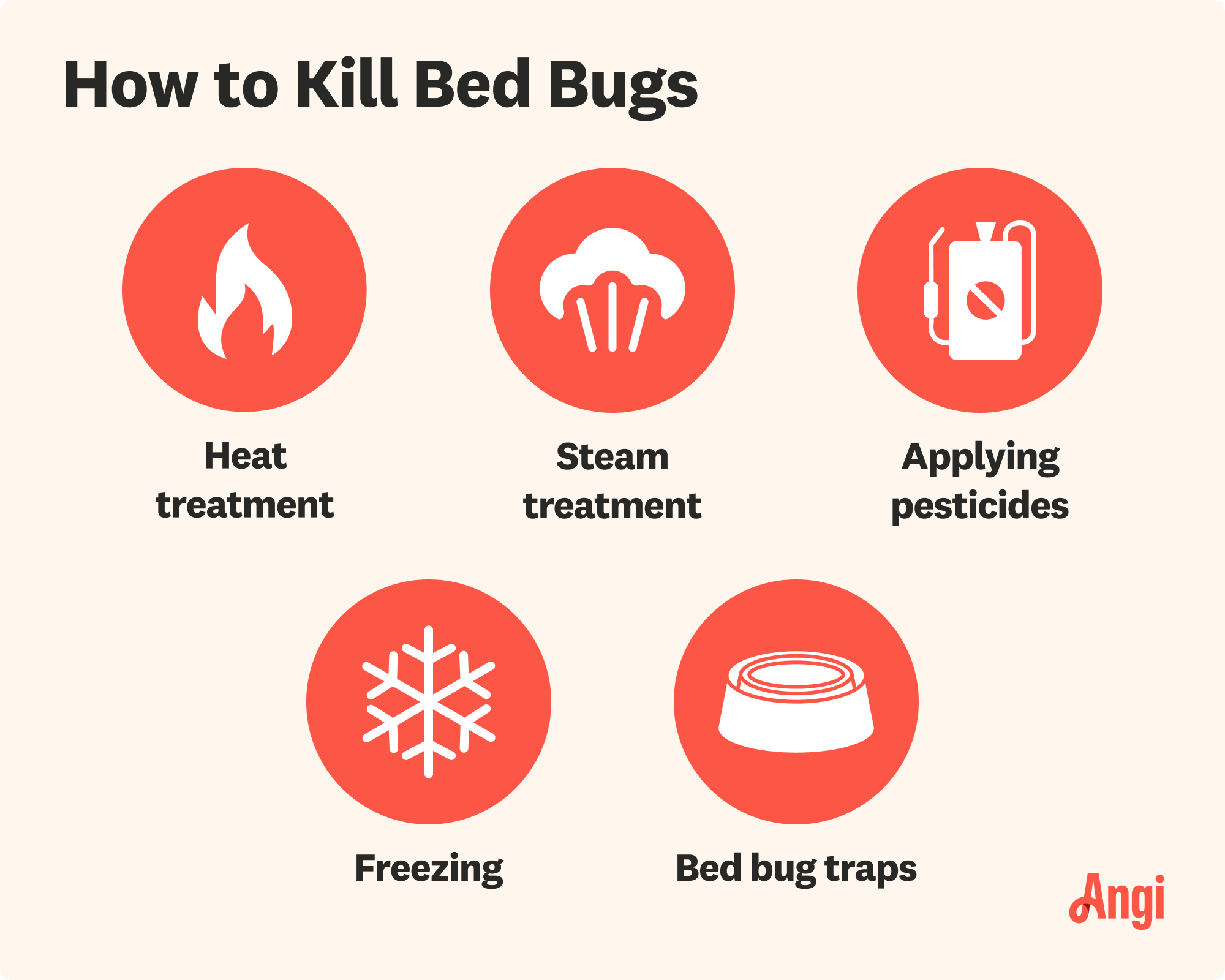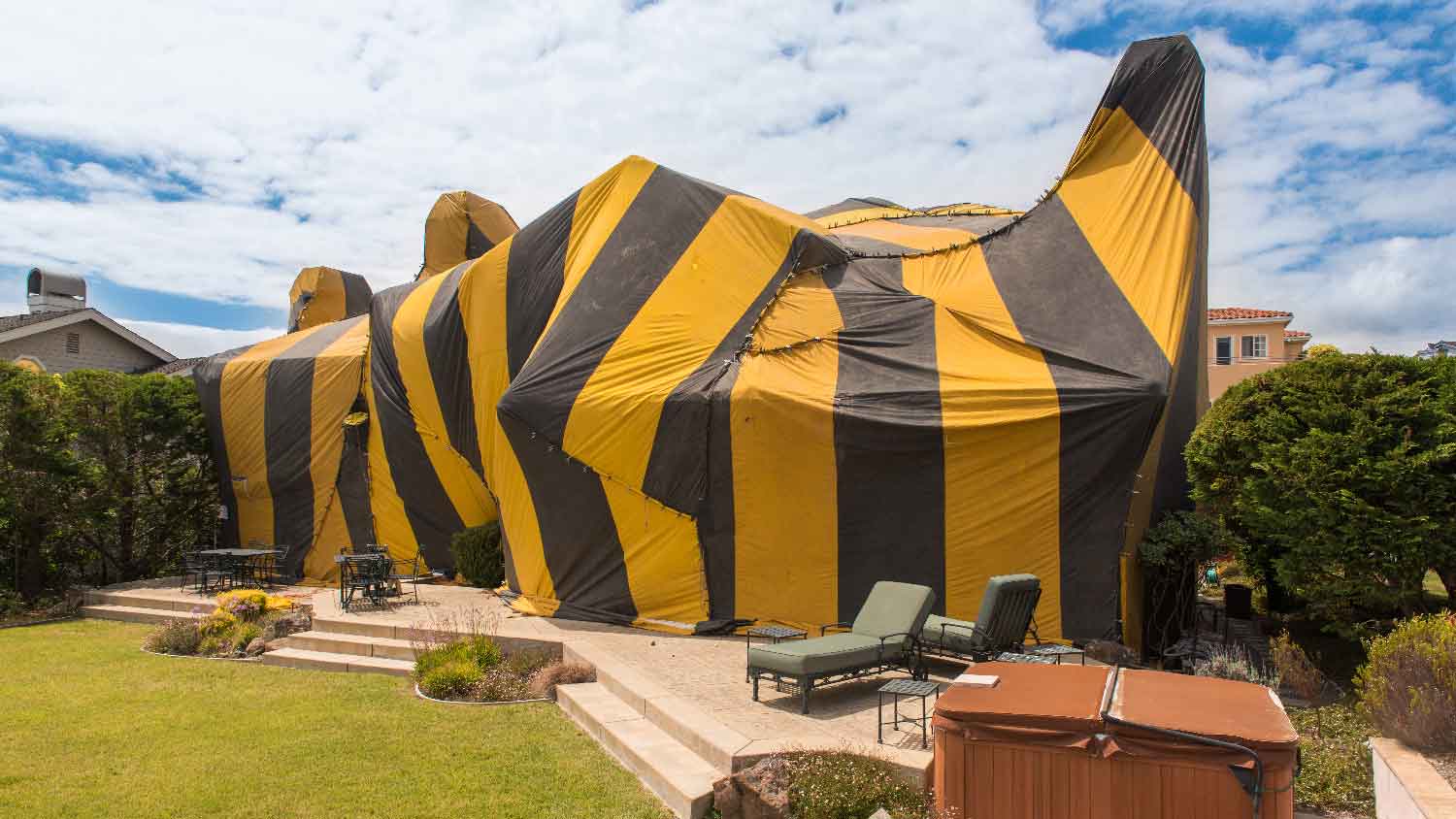
Whether you have bugs, bats, or rodents invading your home, you’ll want to contact an exterminator quickly. Find out how much pest control costs in Columbus, OH.
Don’t let these pests become out of control; safely remove them from your home


Bed bugs can get into your home by attaching to luggage, clothing, and furniture.
Non-toxic bed bug treatments include vacuuming, steam treatment, mattress encasements, and more.
Heat and cold treatments can get in cracks and crevices to eradicate bed bugs.
Diatomaceous earth is a safe non-toxic treatment because it causes bed bugs to die by losing moisture.
A bed bug infestation is one of the worst (and most unpleasant) things a homeowner can deal with, so if you've got one, it's time to take immediate action. However, most people don't like the idea of using toxic chemicals indoors, which is where non-toxic bed bug treatments come in.
In fact, non-chemical options may be some of the most effective ways to get rid of bed bugs. This guide will explain what non-toxic bed bug treatments are available and when they might be most effective.
You may be wondering what attracted bed bugs to your home in the first place. Bed bugs are parasitic insects that feed on the blood of mammals and humans. They are attracted to warm bodies and the carbon dioxide emitted by pets and people. They also like dark environments, which is why they live in areas like the crevices of mattresses, furniture, and clothing.
There are several ways these pests can enter your house and set up shop, too. Although they don’t attach the same way fleas do, they can hitch a ride on items, such as luggage, clothing, and furniture. That’s why inspecting and treating items (like pre-owned clothes and furniture) before bringing them into your home is essential.

There are many options for treating a bed bug infestation that don’t involve chemicals, and they can be very effective if employed in the right circumstances.
| Non-Toxic Bed Bug Treatment | Best For |
|---|---|
| Cleaning up clutter | Preventing mild infestations by removing hiding spots |
| Vacuuming | Addressing early-stage infestations |
| Steam treatment | Treating localized bedbugs and eggs on contact |
| Heat treatment | Handling severe, widespread infestations |
| Cold treatment | Treating specific infested items |
| Diatomaceous earth | Managing ongoing infestations with long-term effects |
| Mattress encasements | Preventing and isolating bedbugs in mattresses |
| Essential oils | Repelling bedbugs in minor infestations |

Cleaning up the clutter in your home is one of the best first steps you can take to tackle bed bugs. Not only can you check something off your errands list, it also removes some of the areas bed bugs like to hide. Doing so will expose them and make it easier to treat them.
If you notice a bed bug infestation, pick up any clothes lying on the floor and keep them in sealed bags for at least 18 months, unless you invest in heat treatments (more to come below). This is a great time to bag and throw away any items that you don’t use anymore, but skip the donation center to avoid spreading the infestation.
If you have items lying around like junk mail, broken household items, or old newspapers, now is the time to dispose of these items. The less clutter in your home, the better for getting rid of these invasive pests as quickly as possible.
Best For: Preventing mild infestations by limiting the number of hiding spots where bed bugs can reside
Vacuuming is another household chore that you should do frequently to eliminate any dirt, debris, and pet hair from your floors. It’s also a great way to help reduce the number of bed bugs in an infestation. Vacuuming won’t solve the problem completely, but it will kill bed bugs instantly and help reduce the severity of the problem.
Be sure to vacuum every inch of your floors, moving furniture out of the way to vacuum underneath and between crevices. Don’t forget to vacuum areas like baseboards, nightstands, and even your mattress to remove live bed bugs and their eggs. As you’re emptying the canister, make sure you empty the dirt into a garbage bag and immediately remove it from your home. Wash the filter and dirt canister with hot soapy water.
Best For: Addressing early-stage infestations or helping reduce the severity of infestations by removing visible bugs and eggs
Heat is a far better way to kill bed bugs than insecticides because these insects can resist chemicals, but they die easily from heat (their thermal death point is around 114 to 115 degrees Fahrenheit). As a result, a pest control professional may use a steam cleaner to tackle a bed bug infestation. You can use steam treatment on mattresses, floorboards, and anywhere else without the risk of damage, or without the risk of spraying a chemical in such places.
This process can be slow, but it ensures that the bed bugs aren’t blown around the room to other surfaces. Also, the slow and steady process ensures that any eggs or live bed bugs have enough steam applied to them to kill them.
Best For: Treating localized infestations on contact
Along with steam cleaning, you can use heat to kill off bed bugs in any stage of life. Since bed bugs can’t thrive in hot temperatures, you can place dryer-friendly items like clothes, pillows, and couch cushion covers into the dryer on the hottest setting. This action will kill any live bed bugs and eggs.
You might go even further and use a thermal heating system to raise the room's temperature to that range for about an hour. This method ensures the heat gets into every crack and crevice in the room. You may have to find a local pest control company that can employ this type of system.
If you choose this option, you’ll need to remove items from your home like houseplants, medications, and flammable items, as this process can raise the temperature in your home to a whopping 145 degrees Fahrenheit. It may seem like a daunting process, but it’s effective at killing bed bugs in an entire infested area instantly.
Best For: Handling severe, widespread infestations by raising the temperature in an entire area
You could go the other direction and freeze the bed bugs to death using what’s known as pressurized carbon dioxide snow. Basically, a pest control company uses a machine with a pressurized cylinder that blasts a "snow" mixture at -108 degrees Fahrenheit which, like the steam, gets in hard-to-reach areas such as baseboards and box springs.
Another option for cold treatment is to utilize your home’s freezer. If you have the space, you can place items like pillows or bedding into a sealed plastic bag and into your freezer. Set the dial to the coldest temperature (0 degrees Fahrenheit or colder), and leave in the freezer for about 4 days. This process will kill any live bed bugs, eggs, and larvae.
Best For: Treating specific infested items
Diatomaceous earth (DE) is essentially dust made from the skeletons of microorganisms known as diatoms. This dust sticks to bed bugs and absorbs a layer of wax on their bodies, which causes them to lose moisture and die. It's entirely safe for use and non-toxic. But be careful not to purchase the type of DE used for swimming pool filters, which is dangerous for inhalation.
This method takes a little more time than other methods, so be patient. On average, you can expect to see results in 2 to 4 weeks, since the bed bugs have to physically come into contact with the powder. But it’s a good option for preventing infestations in the long term.
You can buy DE from most large retailers, with a 4-pound bag costing $12 to $20 on average.
Best For: Managing ongoing infestations with long-term effects
While you might already use a mattress cover to protect it against spills and dirt, using a mattress encasement is a different way to help protect against a bed bug infestation. This bag for your mattress seals the whole mattress inside so that no bed bugs can get into (or out of) the bag.
For this tool to work, the mattress and any box springs must be encased, and the zippers must be fully zipped. It would be best to keep the mattress and box springs fully enclosed for at least one year to ensure that all living bed bugs and eggs die.
Best For: Preventing and isolating bed bugs in mattresses
Did you know that some essential oils do more than just help with a headache? While not a commonly thought-of remedy for this pest, a few essential oils can help with a bed bug infestation. Oils like citronella, thyme oil, and geraniol oil can help repel bed bugs.
It’s important to know that bed bugs can survive a long time (over 400 days) without feeding, which is much longer than the lasting nature of these scents. This means these oils might temporarily repel them, but this non-toxic treatment may not necessarily kill them.
To use the essential oils to repel bed bugs, combine one of the oils (10 to 15 drops should be plenty) with a small amount of rubbing alcohol and distilled water into a spray bottle, and spray around your home, especially around mattresses and other furniture.
Best For: Repelling bed bugs in minor infestations and deterring them from treated areas
Bed bugs aren’t typical insects. These hardy creatures can resist most insecticides, and their eggs are virtually unaffected by these substances. But that’s not the only reason to avoid chemicals when treating bed bugs. These pests like to hide away in clutter and can often be found infesting beds and box springs, so using insecticides isn’t a good idea because of their toxic effects on humans. As a result, many people turn to non-chemical options for treating an infestation.
Contact a pest control professional near you to get a consultation for a bed bug problem. They may recommend other non-chemical techniques to deal with your infestation. The pros can look at your home and your specific infestation to recommend some next steps and provide tips to prevent future bed bug infestations. Depending on what you're dealing with, they may recommend one of the solutions above or a combination of several options.
If the infestation is limited enough, they may only need to clear a few areas of clutter and do some vacuuming. If it's more extensive, it may be a longer job with some more in-depth treatments. The cost of a full bed bug home treatment ranges from $300 to $5,000, depending on the severity of the infestation and the treatment method used. The best way to put your mind at ease is to get a pro on the case quickly to help minimize the problem.
From average costs to expert advice, get all the answers you need to get your job done.

Whether you have bugs, bats, or rodents invading your home, you’ll want to contact an exterminator quickly. Find out how much pest control costs in Columbus, OH.

Tenting is a costly but effective way to exterminate termites. Learn the average termite tenting cost and everything that will factor into your budget.

Your mosquito misting system cost will vary based on factors such as the size, type, brand, and more. Find out what the budget for this system looks like.

Ready to get bed bugs out of your home? With this guide, see the risks and benefits of using professional bed bug pesticides for the task.

If your dog brought some unwelcome pests into bed with you, learn how to get rid of fleas in bed before you’re covered in itchy bites.

Discover methods for how to get rid of rabbits using humane tactics, including fences, repellents, and a decoy garden. Get ready to send those bunnies hopping.